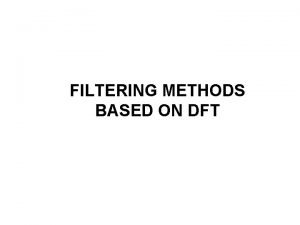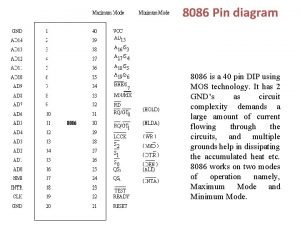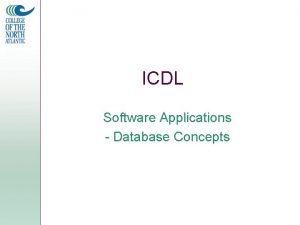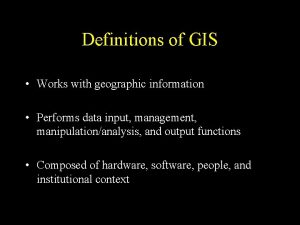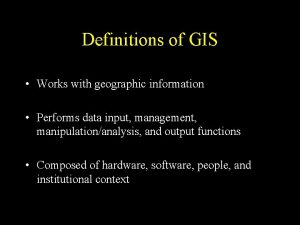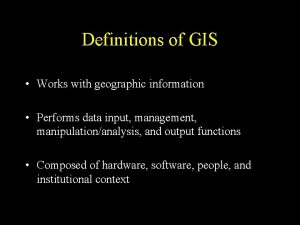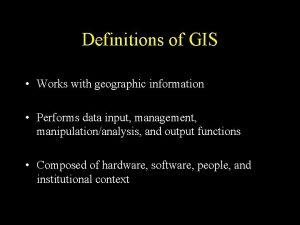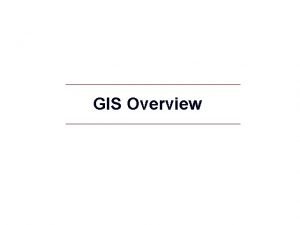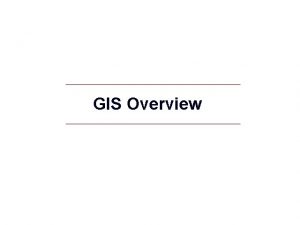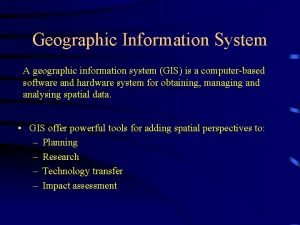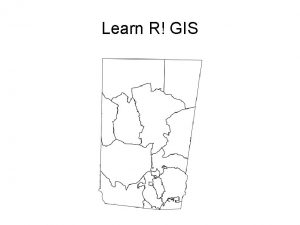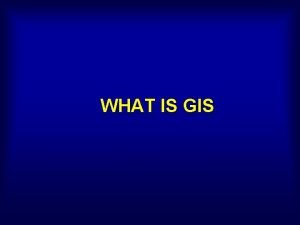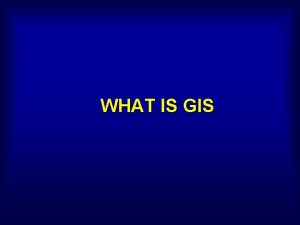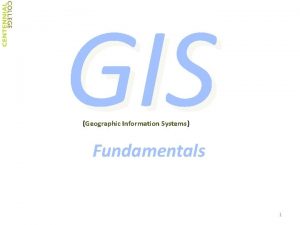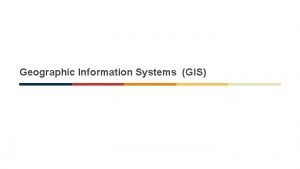Definitions of GIS Works with geographic information Performs














- Slides: 14

Definitions of GIS • Works with geographic information • Performs data input, management, manipulation/analysis, and output functions • Composed of hardware, software, people, and institutional context

Definitions of GIS • Primary related technologies – computer cartography – database management (information technology) – computer graphics – remote sensing – computer aided design (CAD)

Why use GIS? • GIS provides – data integration and standardization – methods for managing large volumes of data – advanced spatial analysis capabilities – automation of repetitive tasks – sophisticated means of communication: distribution and output

Applications of GIS Four basic categories: – environmental/natural resource management – urban and regional management – infrastructure management – commercial

Ways of storing digital data • File structures – simple – ordered sequential – indexed • Databases and data models – hierarchical – network – relational

Relational data model Student ID Last First Grade Class 1 Wood Bob C Geog 357 2 Kent Chuck B Geog 115 3 Smith Jane A Geog 357 4 Boone Dan B Geog 357 Class Name #Stud Instructor Geog 20 120 Brower Geog 115 120 Mennis Geog 357 48 Mennis Instructor Name Office Mennis 332 Brower 517

Spatial Data Representation Conceptual Model Data Modeling Levels Data Model Data Structure File Structure

Spatial Data Representation • Can distinguish between two different conceptualizations of geographic phenomena: – object view: empty space ‘littered’ with objects (e. g. lakes) – field view: a geographic entity that ‘varies’ across a space (e. g. elevation)

Spatial Concepts • Mathematical Types of Space – Euclidean – Network – Metric – Topologic

Spatial data models • Raster – exhaustive regular or irregular partitioning of space – associated with the field view – location-based • Vector – points, lines, areas – associated with the object view – object-based

Vector data model • TIN: Triangulated Irregular Network

Vector data input and editing Digitizing Process: • • prepare map sheet digitize the coverage identify and correct digitizing errors build topology identify and correct topology errors assign attributes identify and correct attribute errors

Raster data models • A raster representation is composed a series of layers, each with a theme

Raster data models • Compression of raster data: – run length encoding – value point encoding – chain codes – block codes – quadtrees
 Ethan is observing chemical and physical properties
Ethan is observing chemical and physical properties Safety at streetworks
Safety at streetworks The skin performs all of the following except
The skin performs all of the following except A subprogram that performs a specific task
A subprogram that performs a specific task Becker & smith cpas performs
Becker & smith cpas performs Julio has fragmented thinking and distorted false beliefs
Julio has fragmented thinking and distorted false beliefs To which city does romeo go after being exiled from verona
To which city does romeo go after being exiled from verona This operator performs integer division.
This operator performs integer division. 8 bit gaurav
8 bit gaurav Filtering methods based on dft
Filtering methods based on dft What type of cell performs cellular respiration
What type of cell performs cellular respiration The active low iowr signal performs
The active low iowr signal performs Compiler frontend vs backend
Compiler frontend vs backend Why did marcus garvey’s movement fall apart?
Why did marcus garvey’s movement fall apart? A computed is a calculation that a dbms performs
A computed is a calculation that a dbms performs









